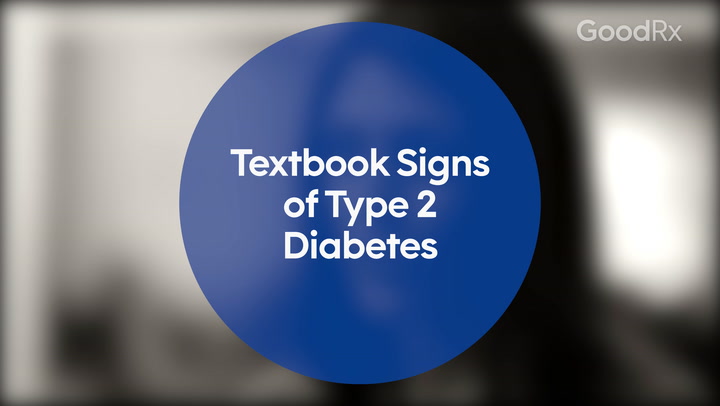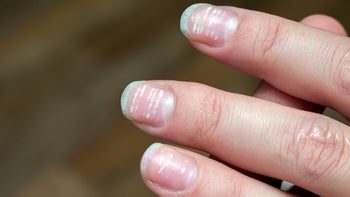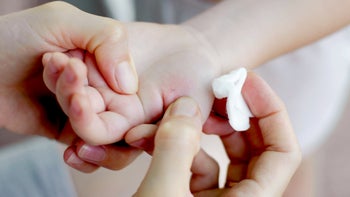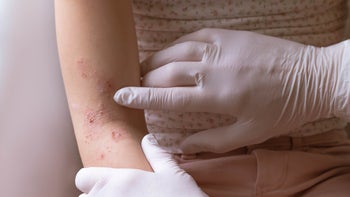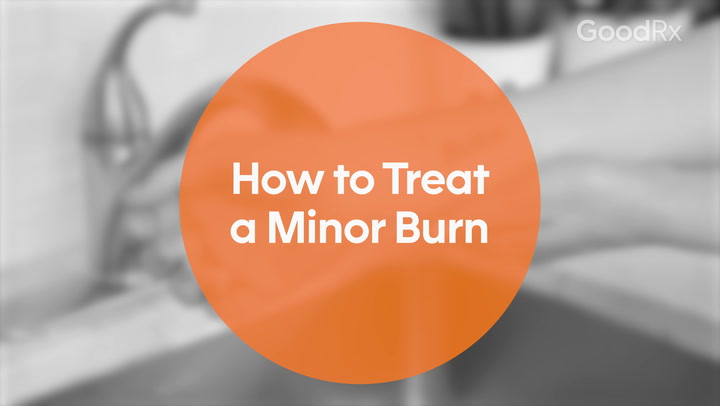
Aquaphor vs. Vaseline for Dry Skin: What Are the Differences and Which Is Better?
Key takeaways:
Aquaphor and Vaseline can boost skin health in many ways by creating a barrier on the skin to prevent water loss. This helps keep skin hydrated.
While they look and feel similar, their ingredients are different. Aquaphor combines petrolatum with several moisturizing and skin-healing ingredients. Vaseline is 100% petrolatum.
Aquaphor is the better choice to use on very dry skin, chapped lips, and eczema. Vaseline is a better choice for wound healing and slugging.
Table of contents

Aquaphor and Vaseline are brand names for two popular skin ointments. They look and feel very similar. And both products have a petrolatum base.
But upon closer inspection, the two products have some differences. So, each has its own health benefits and recommended uses. Here, we’ll break down the differences between Aquaphor and Vaseline, and discuss when to pick one over the other.
How Aquaphor and Vaseline work
Aquaphor and Vaseline are both occlusive moisturizers. This means they form a thick, protective layer on your skin. This layer achieves a few different functions.
Search and compare options
Keeps skin hydrated
Your skin loses water every day. This is called transepidermal water loss (TEWL). Aquaphor and Vaseline create a physical barrier on the skin that reduces this water loss. By sealing in moisture, the skin stays hydrated.
Strengthens the skin barrier
The outermost layer of your skin, the skin barrier, contains fatty acids and moisture. The skin barrier shields you from toxins, bacteria, viruses, and environmental pollution. But when your skin is dehydrated, the barrier becomes damaged and doesn’t function as well. Vaseline and Aquaphor keep this barrier hydrated and healthy so it can perform its protective role.
Creates a physical block
These ointments aren’t actually antibacterial, meaning they don’t kill bacteria. But they form a physical barrier that blocks microorganisms from entering an exposed wound.
May help improve skin tone and texture
As part of a skin care regimen, occlusive moisturizers can help improve skin tone and texture. They do this by hydrating the skin and reducing the appearance of wrinkles. This is the theory behind the viral skin care trend slugging. In slugging, you top your moisturizer with a thin layer of Vaseline or Aquaphor (more on that later).
Ingredients in Aquaphor vs. Vaseline
Aquaphor and Vaseline each make several products. For the sake of this comparison, we'll be looking at the ingredients in their flagship products, Vaseline Original Healing Jelly and Aquaphor Healing Ointment.
Vaseline ingredients
Vaseline has only one ingredient: 100% white petrolatum (also called petroleum jelly).
Can slugging improve skin health? The trendy skin treatment may improve the texture and appearance of your skin, especially if you’re prone to dryness. Learn who should try it, and how to do it.
Foods and drinks for glowing skin: Blackberries, edamame, and almonds are just a few of the foods with nutrients that can help keep your skin healthier and more youthful-looking.
How often should you exfoliate your face? Each person’s exfoliation routine will vary depending on skin type, skin conditions, and goals. See what’s right for you.
The National Institutes of Health classifies white petrolatum as a first aid ointment that can soothe dry and cracked skin. It’s also intended to aid the healing of minor cuts, scrapes, and rashes.
Aquaphor ingredients
Aquaphor contains 41% petrolatum, along with several other ingredients. Aside from one thickener, all the ingredients in Aquaphor have some benefit for your skin:
Mineral oil: Like petrolatum, mineral oil is an occlusive moisturizer. Mineral oil has been shown to help soften the skin and strengthen the skin’s barrier.
Lanolin alcohol: Lanolin alcohol is made from lanolin, a fat that comes from sheep’s wool. Lanolin helps with wound healing and is a very effective emollient moisturizer. But it can cause contact dermatitis, especially in those who are allergic to wool.
Panthenol: Panthenol is a humectant, an ingredient that attracts and holds onto water molecules. It’s also an emollient, a substance that helps soothe and soften skin. Like mineral oil, panthenol plays a role in improving skin barrier function.
Glycerin: Glycerin is a highly effective humectant moisturizer that increases the skin’s ability to hold onto water. It also helps with wound healing, preventing bacterial overgrowth and reducing scarring.
Bisabolol: Bisabolol is a plant extract sourced from chamomile. It can soothe inflamed skin, reduce eczema, and improve skin texture.
Ceresin: This thickener and emulsifier prevents the ingredients from separating. Ceresin doesn’t have much benefit to the skin, but it gives Aquaphor a more appealing texture.
Read more like this
Explore these related articles, suggested for readers like you.
Aquaphor vs. Vaseline health benefits
Aquaphor and Vaseline are often used interchangeably (and often recommended interchangeably by dermatologists). Which one to use often comes down to personal preference. As an example, Vaseline is a bit thicker and greasier than Aquaphor, and some people don’t love its texture. Ultimately, people tend to use the one they’re more familiar with, or whichever one they have on hand.
But Aquaphor and Vaseline are not identical. While there’s some overlap in the health benefits they provide, they function a bit differently. So, one ointment may be more effective than the other, depending on the skin issue. Here’s the breakdown.
Wound care
Vaseline was invented to soothe wounds and burns, and that’s still one of its most effective uses today.
Occlusive moisturizers speed up wound healing. They prevent the skin from drying out, which, in turn, prevents the formation of a scab. According to the American Academy of Dermatology, wounds with scabs take longer to heal.
Keeping the skin moist can also:
Reduce scarring
Soothe itching
Protect against bacterial infections
Because Aquaphor is petrolatum-based, it’s also effective for wounds. But in some situations, Vaseline may be the better choice.
There haven’t been a lot of studies comparing Vaseline and Aquaphor. In one study, researchers compared the healing effects of Aquaphor and Vaseline on surgical wounds. They found that while both reduced swelling, wounds treated with Aquaphor had more redness. Additionally, it’s not recommended to use Aquaphor on deep wounds.
Best for the job: Vaseline edges out Aquaphor for wound care, since some of the ingredients in Aquaphor shouldn’t be used on deep or puncture wounds. However, for minor wounds and scars, Aquaphor can also be used. Vaseline may also do a better job of reducing redness.
Slugging
Slugging involves spreading a thin layer of occlusive ointment (such as Vaseline or Aquaphor) to your face on top of your moisturizer. Then you leave it on overnight.
Slugging has three purported benefits:
Prevents water loss from your skin
Seals in moisture from your lotion or cream
Helps protect and repair your skin barrier
Petrolatum reduces water loss by as much as 98%. Lanolin and mineral oil (two ingredients in Aquaphor) reduce water loss by only 20% to 30%.
Best for the job: Both Vaseline and Aquaphor are great for slugging, and which you use may come down to personal preference. While research suggests that 100% petrolatum is better at reducing water loss than other occlusives, Aquaphor has additional humectant and emollient ingredients that can be beneficial for the skin.
Dry and chapped lips
Both Vaseline and Aquaphor can help soothe dry, chapped lips, but in different ways.
Vaseline is better as a preventative. Because it significantly reduces water loss, putting Vaseline can hold moisture in. This makes chapped lips less likely to happen in the first place. If you already have dry or chapped lips, Vaseline can also soften the flaky skin, so it doesn’t split and tear.
Since it also contains petrolatum, Aquaphor can also do these things. But Aquaphor also contains panthenol and glycerin, which are highly effective moisturizers. Because of this, Aquaphor may prevent chapped lips and moisturize the skin, instead of just softening it.
Best for the job: While both products can work, Aquaphor may be a better choice for lips. It has occlusive, emollient, and humectant (moisturizing) ingredients. So it can prevent water loss from your skin, and moisturize and soothe chapped lips.
Dry skin/eczema
As with chapped lips, Vaseline can help soothe dry skin and eczema, but it doesn’t moisturize it. On the other hand, Aquaphor contains other ingredients, like bisabolol, which can ease eczema and soothe inflamed skin.
Best for the job: Thanks to moisturizing and soothing ingredients like bisabolol, Aquaphor may be better at alleviating dry skin and eczema.
Safety, side effects, and risks
Both Vaseline and Aquaphor are generally considered mild and safe.
Reactions to Vaseline are rare. There have been some older reports of contact dermatitis, but it’s generally safe for those who aren’t sensitive to it.
Because of its additional ingredients, Aquaphor has more of a potential for side effects. There have been some reports of allergic contact dermatitis to bisabolol, mostly in children. In addition, about 5% of people are allergic to lanolin. For these people, lanolin may cause rashes and contact dermatitis.
It’s also worth noting that lanolin is sourced from sheep’s wool. While lanolin is considered cruelty-free, it’s not vegan. If you want to avoid animal products completely, opt for Vaseline instead.
Frequently asked questions
Yes, you can use both ointments on your face, and both are often used in slugging. Because it’s 100% petroleum jelly, Vaseline is more effective at reducing water loss from the skin. However, it’s thicker and greasier than Aquaphor, so some people may prefer to use Aquaphor.
There’s no scientific evidence that either ointment benefits eyelashes. Still, some influencers on social media suggest that that putting a small amount of Aquaphor or Vaseline on your eyelashes can benefit them by:
Adding moisture
Enhancing curl pattern
Contributing to growth
But note these claims are anecdotal. There isn’t research to support these claims.
Because they feel somewhat greasy, it’s a common misconception that Aquaphor and Vaseline clog pores. However, both are considered noncomedogenic, which means they don’t clog pores and aren’t known to cause acne. That said, if you don’t adequately cleanse your face before applying, Aquaphor and Vaseline can trap dirt and oil, which can lead to clogged pores. Additionally, if you have oily or acne-prone skin, overusing Aquaphor and Vaseline may trigger a breakout in some people.
You shouldn’t use Aquaphor on infections, sunburns, open sores, or deep puncture wounds. Anyone who’s allergic to lanolin should also avoid Aquaphor since that’s one of the main ingredients.
The bottom line
Aquaphor and Vaseline are both occlusive ointments with a petrolatum base. They’re often used interchangeably. Both can provide benefits for the skin, such as preventing water loss and strengthening the skin barrier. But for all their similarities, Aquaphor and Vaseline contain different ingredients. That means that each has the ability to treat different skin issues. Vaseline may be the better choice for wound healing and slugging, while Aquaphor is more effective at moisturizing dry skin and chapped lips, and soothing eczema.
Ultimately, which ointment you use comes down to which works best for your skin. Aquaphor contains several moisturizing and skin-healing ingredients that Vaseline doesn’t have. But these ingredients can cause side effects in people sensitive to them.
Why trust our experts?



References
American Academy of Dermatology Association. (n.d.). Proper wound care: How to minimize a scar.
Draelos, Z. D., et al. (2019). The low prevalence of allergic contact dermatitis using a petrolatum ointment containing lanolin alcohol. Journal of Drugs in Dermatology.
Eddin, L. B., et al. (2022). Health benefits, pharmacological effects, molecular mechanisms, and therapeutic potential of α-bisabolol. Nutrients.
Jacob, S. E., et al. (2011). Compositae-associated allergic contact dermatitis from bisabolol. Dermatitis.
Kamrani, P., et al. (2024). Petroleum jelly: A comprehensive review of its history, uses, and safety. Journal of the American Academy of Dermatology.
Kang, H., et al. (2004). Allergic contact dermatitis to white petrolatum. The Journal of Dermatology.
Kanwar, A. J. (2018). Skin barrier function. Indian Journal of Medical Research.
Kono, T., et al. (2021). Clinical significance of the water retention and barrier function‐improving capabilities of ceramide‐containing formulations: A qualitative review. The Journal of Dermatology.
Morales-Burgos, A., et al. (2013). Postoperative wound care after dermatologic procedures: a comparison of 2 commonly used petrolatum-based ointments. Journal of Drugs in Dermatology.
Pavlačková, J., et al. (2019). In vivo efficacy and properties of semisolid formulations containing panthenol. Journal of Cosmetic Dermatology.
Rawlings, A. V., et al. (2012). A review on the extensive skin benefits of mineral oil. International Journal of Cosmetic Science.
Sethi, A., et al. (2016). Moisturizers: The slippery road. Indian Journal of Dermatology.
Silverberg, J. I., et al. (2022). Lanolin allergic reactions: North American contact dermatitis group experience, 2001 to 2018. Dermatitis.
Stout, E. I., et al. (2012). Glycerin-based hydrogel for infection control. Advances in Wound Care.
Stratus Pharmaceuticals. (2022). White petrolatum- petrolatum ointment.










